#213: Crucibulum laeve
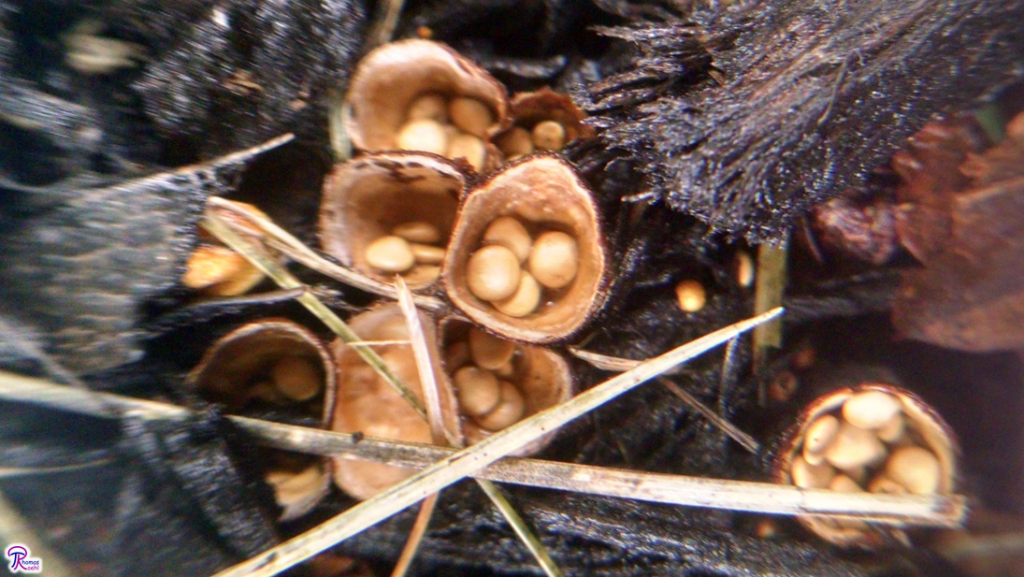
Crucibulum laeve is a common bird’s nest fungus that is easily recognized by its yellow nest and whitish eggs.
Bird’s nest mushrooms are some of my favorite mushrooms to show people when introducing them to the amazingly diverse world of mushrooms. The fact that there are tiny mushrooms that look like a bird’s nest still stuns me. The two most common bird’s nest mushrooms that I find are Cyathus striatus (FFF#147) and Crucibulum laeve. C. striatus is larger and more likely to be seen, but C. laeve is probably more common. C. laeve is most visible when young; in that stage it has a yellow to orange membrane sealing the top of the nest that makes it easy to spot on brown mulch, twigs, and other small pieces of wood. Once you find it, the mushroom is easy to identify; C. laeve is the only North American bird’s nest mushroom with white eggs and a yellow nest.1
Description
C. laeve produces tough, roughly cylindrical mushrooms that are often slightly wider than they are tall. The mushrooms grow 4-10mm wide and 2-10mm tall. C. laeve usually grows in clusters, sometimes with mushrooms bumping into one another. This can distort the circular shape of the mushrooms, making them more angular.1–4
Until the spores are mature, a lid called an “epiphragm” covers the cylinder. The epiphragm is yellowish to orangish and velvety. When C. laeve grows on mulch, the bright color of this membrane makes the mushrooms easy to find. Once the spores are mature, the lid breaks apart to reveal a cup-shaped interior with a pile of circular packets of spores at the bottom. The mushroom continues to grow a little and the rim of the cup expands and flares out slightly.1–4
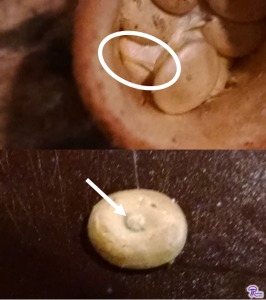
The eggs of C. laeve are attached to the nest by a thin cord called a funiculus. This cord is somewhat visible in the circled area above. The arrow points to the area on the bottom of the egg where the funiculus attaches.
The outer surface of the mushroom’s nest is smooth to slightly velvety or slightly wrinkled. It starts out yellowish but often darkens to brown as the mushroom ages. The interior of the nest is smooth and shiny and significantly lighter than the rest of the mushroom. This surface is somewhat variable in color, ranging from whitish to greyish to light brown.1–4
Inside the nest, C. laeve produces usually five to eight eggs that are actually packets of spores called “peridioles.” Each peridiole is a whitish pancake-shaped disc and is attached to the nest wall by a thin cord called a “funiculus.”1–4 The nest shape uses the energy of falling raindrops to splash the eggs out of the nest. As the peridiole launches, the funiculus stretches out and tears away from the nest. The end of the funiculus is now frayed and sticky, which helps it attach to any leaves or twigs the peridiole passes during its flight. If the funiculus sticks to something, the peridiole’s momentum causes it to wrap around the object like a tetherball, which ensures the peridiole will stay stuck to the object. Now that it is stuck to an object well above the ground, the peridiole’s outer layer will disintegrate and drop its spores into the air below.2
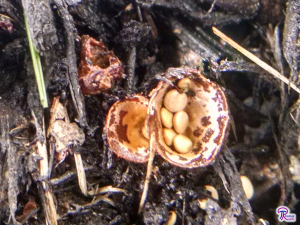
One of the best places to find C. laeve is in mulch after it rains. Look for it from spring through fall.
Ecology
This little mushroom decomposes just about any small piece of wood. It appears on sticks, woodchips, nutshells, and similar debris but tends to shy away from large pieces of wood. C. laeve can also decompose dung, but that is less common. This bird’s nest mushroom appears from spring through fall (or year-round in warmer climates) all across North America and in temperate areas of Europe and Asia.1–4
Similar Species
There are only two species of Crucibulum in North America. As a result, C. laeve has only one good lookalike: C. parvulum. The nest of C. parvulum is whitish and smaller, forming a nest no larger than 3mm across. This should make it fairly easy to separate from C. laeve. C. parvulum is also limited to northern areas of the continent, so in most places you don’t even have to worry about that species.5
All other species of bird’s nest mushrooms in North America have eggs that are darker in color, from reddish to brownish to greyish.1,5 Species of Nidula are probably the mushrooms closest in appearance to Crucibulum, but they have darker eggs and do not form a funiculus. Nidularia and Mycocalia do not form a nest, just a pile of eggs. Cyathus species tend to form taller mushrooms with a fuzzy external surface and darker eggs.5
Edibility
It probably doesn’t come as a shock to you that this mushroom is not edible.1,3,4 It’s way too small and its flesh is too tough.1,4 The most edible part of this mushroom is probably the eggs before they mature, but you’d need to gather a staggering number of peridioles just for a taste. Of course, nobody knows whether C. laeve is poisonous since nobody has ever bothered to eat enough of the mushrooms. It probably isn’t poisonous, but it’s not worth taking the time to find out. As Gary Emberger writes in his online field guide, “One simply does not eat things such as this.”3 (Of course, I imagined Sean Bean as Boromir saying this.)
Taxonomy and Etymology
C. laeve has a boring taxonomic history. It was originally described in 1778 and received its current name in 1936.4 Along with the rest of the bird’s nest genera, C. laeve belongs in the family Agaricaceae.6–9 This means some of its closest relatives are gilled mushrooms in the genus Agaricus, including the button mushroom you find in grocery stores: Agaricus bisporus (FFF#002).10
The name Crucibulum translates to “little pot” and laeve means “smooth” (indicating the nest’s interior walls). Thus, the mushroom’s scientific name means “smooth little pot.” C. laeve does have a couple common names – “White-Egg Bird’s Nest” and “Common Bird’s Nest” – but those are not used very often.3
| Kingdom | Fungi |
| Division (Phylum) | Basidiomycota |
| Subdivision (Subphylum) | Agaricomycotina |
| Class | Agaricomycetes |
| Subclass | Agaricomycetidae |
| Order | Agaricales |
| Family | Agaricaceae |
| Genus | Crucibulum |
| Species | Crucibulum laeve (Scop.) V.S. White6 |
See Further:
http://www.mushroomexpert.com/crucibulum_laeve.html
http://www.mykoweb.com/CAF/species/Crucibulum_laeve.html
Citations
- Wood, M. & Stevens, F. California Fungi—Crucibulum laeve. The Fungi of California Available at: http://www.mykoweb.com/CAF/species/Crucibulum_laeve.html. (Accessed: 2nd June 2018)
- Kuo, M. Crucibulum laeve. MushroomExpert.Com (2014). Available at: http://www.mushroomexpert.com/crucibulum_laeve.html. (Accessed: 2nd June 2018)
- Emberger, G. Crucibulum laeve. Fungi Growing on Wood (2008). Available at: http://www.messiah.edu/Oakes/fungi_on_wood/bird%27s%20nest%20fungi/species%20pages/Crucibulum%20laeve.htm. (Accessed: 2nd June 2018)
- O’Reilly, P. Crucibulum laeve (Huds.) Kambly – Common Bird’s-nest Fungus. First Nature Available at: https://www.first-nature.com/fungi/crucibulum-laeve.php. (Accessed: 2nd June 2018)
- Kuo, M. The Bird’s Nest Fungi. MushroomExpert.Com (2014). Available at: http://www.mushroomexpert.com/birdsnests.html. (Accessed: 2nd June 2018)
- Crucibulum laeve. Mycobank Available at: http://www.mycobank.org/Biolomics.aspx?Table=Mycobank&Rec=7037&Fields=All. (Accessed: 2nd June 2018)
- Cyathus. Mycobank Available at: http://www.mycobank.org/Biolomics.aspx?Table=Mycobank&Rec=56389&Fields=All. (Accessed: 2nd June 2018)
- Nidula. Mycobank Available at: http://www.mycobank.org/Biolomics.aspx?Table=Mycobank&Rec=57024&Fields=All. (Accessed: 2nd June 2018)
- Nidularia. Mycobank Available at: http://www.mycobank.org/Biolomics.aspx?Table=Mycobank&Rec=57025&Fields=All. (Accessed: 2nd June 2018)
- Agaricus bisporus. Mycobank Available at: http://www.mycobank.org/BioloMICS.aspx?TableKey=14682616000000067&Rec=708&Fields=All. (Accessed: 2nd June 2018)

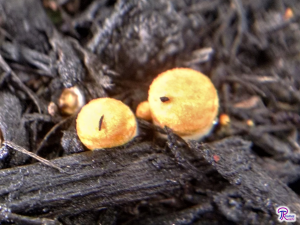

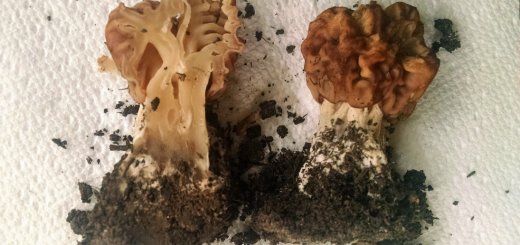
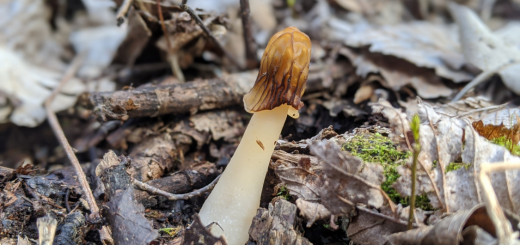
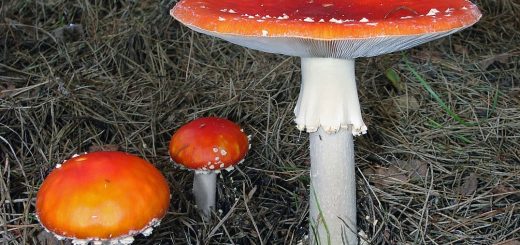





![#011: Characteristics of Kingdom Fungi [Archived]](https://www.fungusfactfriday.com/wp-content/themes/hueman/assets/front/img/thumb-small-empty.png)
